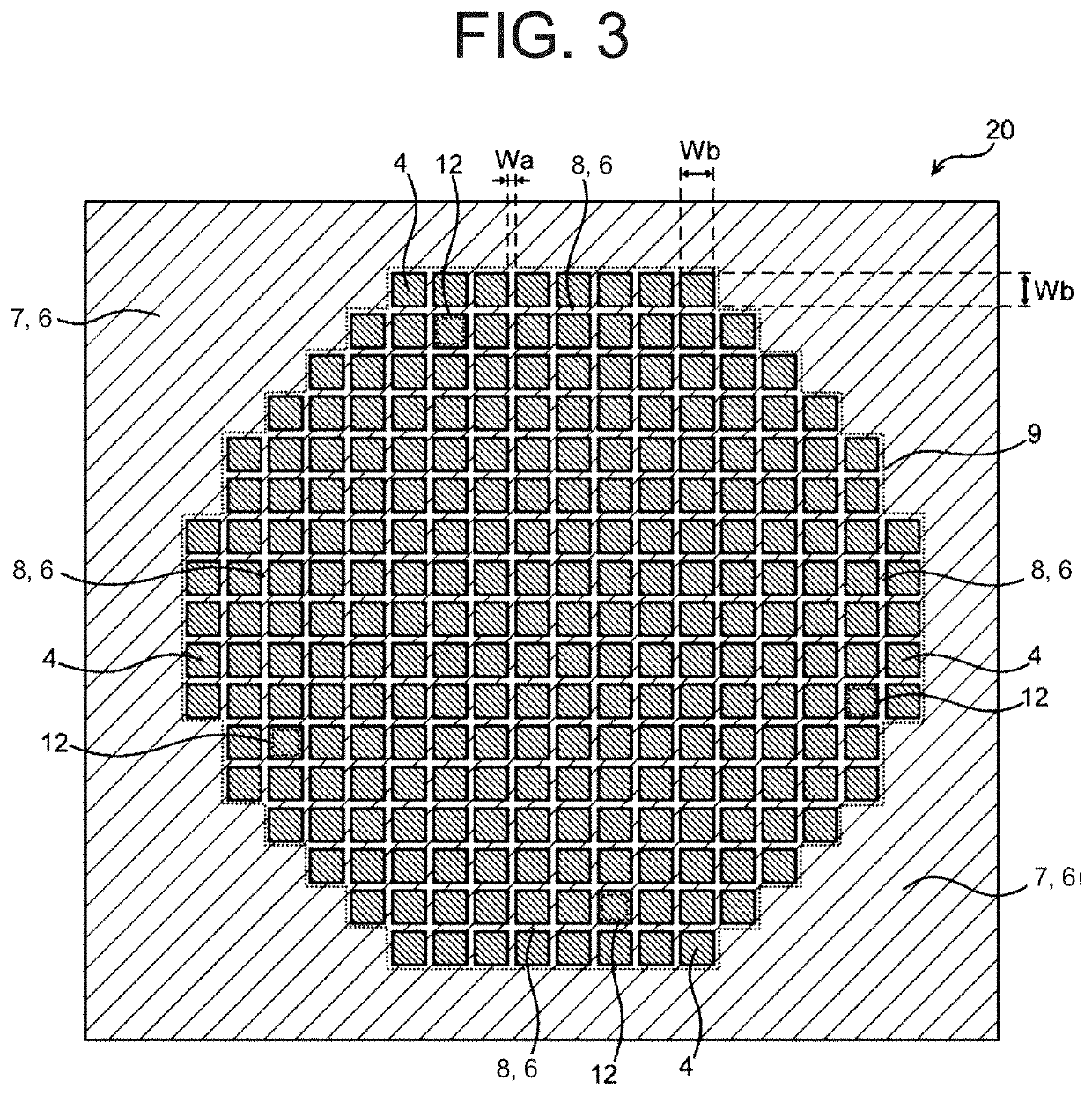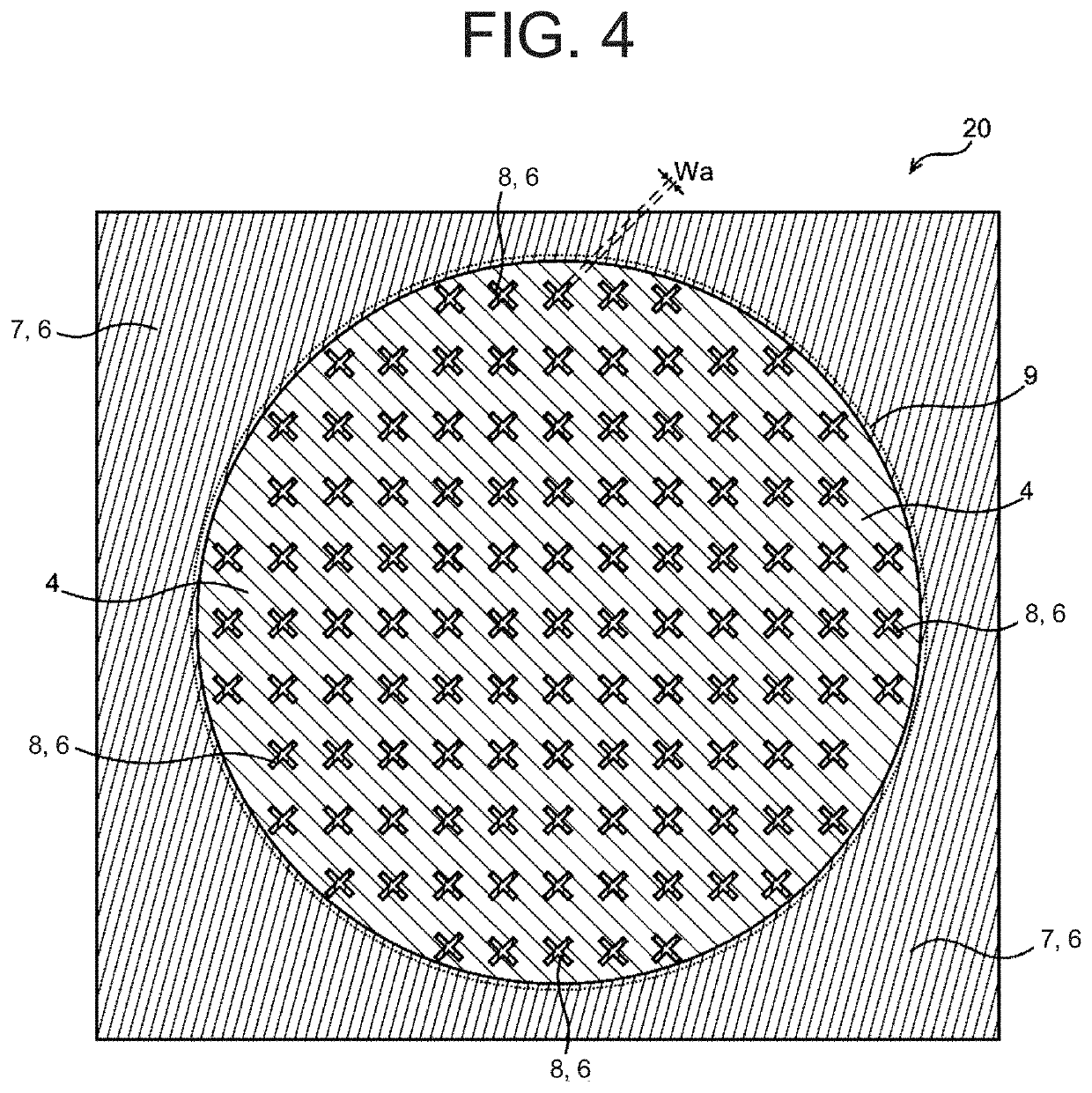Electron emitting element
- Summary
- Abstract
- Description
- Claims
- Application Information
AI Technical Summary
Benefits of technology
Problems solved by technology
Method used
Image
Examples
first embodiment
[0030]FIG. 1 is a plan view of an electron emitting element according to the present embodiment. FIG. 2 is a schematic cross-sectional view of the electron emitting element taken along the broken line A-A in FIG. 1. FIG. 3 is a schematic cross-sectional view of the electron emitting element taken along the broken line B-B in FIG. 2.
[0031]The electron emitting element 20 of the present embodiment includes a lower electrode 3, a surface electrode 5 facing the lower electrode 3, a resistance layer 4 arranged between the lower electrode 3 and the surface electrode 5, and an insulating layer 6 arranged between the lower electrode 3 and the surface electrode 5. The resistance layer 4 is an insulating resin layer containing conductive fine particles in a dispersed state. The lower electrode 3, the resistance layer 4, and the surface electrode 5 are provided such that electrons flow to the resistance layer 4 as a result of a potential difference being generated between the lower electrode 3...
second embodiment
[0058]In the second embodiment, the overall shape of the insulating layer 6 constituting the emission control region 8 is a cross pattern. FIG. 4 is a schematic cross-sectional view of an electron emitting element according to the second embodiment. This cross-sectional view corresponds to the cross-sectional view shown in FIG. 3 of the first embodiment.
[0059]The emission control region 8 can have a pattern in which cross-shaped insulating layers 6 are evenly distributed in the electron emission region 9. In this way, by making the overall shape of the emission control region 8 a cross pattern, the overall length of the edges of the emission control region 8 can be made longer. Therefore, a large number of electron emission points can be formed in the electron emission region 9.
[0060]Furthermore, the overall shape of the emission control region 8 may be a shape that combines a lattice pattern as in the first embodiment and the cross pattern of the second embodiment.
[0061]The other c...
third embodiment
[0062]In the third embodiment, the overall shape of the insulating layer 6 constituting the emission control region 8 is a concentric circular shape. FIG. 5 is a schematic cross-sectional view of an electron emitting element according to the third embodiment. This cross-sectional view corresponds to the cross-sectional view shown in FIG. 3 of the first embodiment.
[0063]The emission control region 8 having a concentric circular shape can be provided so that the insulating layer 6 is evenly distributed in the electron emission region 9. In this way, by making the overall shape of the emission control region 8 a concentric circular shape, the overall length of the edges of the emission control region 8 can be made longer. Therefore, a large number of electron emission points can be formed in the electron emission region 9.
[0064]Furthermore, the overall shape of the emission control region 8 may be a shape that combines a lattice pattern as in the first embodiment and the concentric cir...
PUM
 Login to View More
Login to View More Abstract
Description
Claims
Application Information
 Login to View More
Login to View More - R&D
- Intellectual Property
- Life Sciences
- Materials
- Tech Scout
- Unparalleled Data Quality
- Higher Quality Content
- 60% Fewer Hallucinations
Browse by: Latest US Patents, China's latest patents, Technical Efficacy Thesaurus, Application Domain, Technology Topic, Popular Technical Reports.
© 2025 PatSnap. All rights reserved.Legal|Privacy policy|Modern Slavery Act Transparency Statement|Sitemap|About US| Contact US: help@patsnap.com



